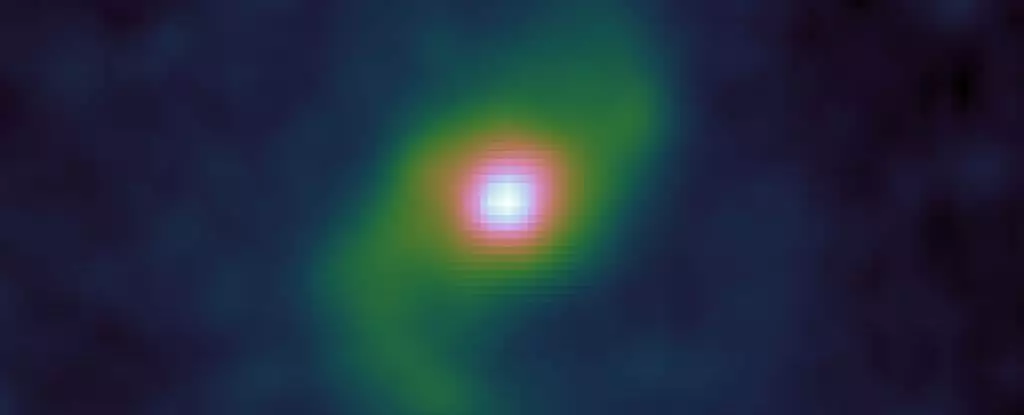In an astonishing leap into the depths of the cosmos, astronomers have unveiled a spiral galaxy named J0107a, which is reshaping our comprehension of galactic evolution during the infancy of the Universe. Formed a scant 2.6 billion years after the Big Bang, this galaxy exhibits a remarkable sophistication that challenges our current models. The emergence of such a well-structured formation at this early stage raises more questions than answers, compelling scientists to rethink long-held beliefs about how galaxies initially took shape.
Previously, the timeline of galaxy formation was presumed to be a gradual process, marked by the slow accumulation of matter around nascent black holes. However, the discovery of J0107a indicates a surprising immediacy in the evolution of galactic structures, suggesting that substantial entities can materialize much faster than previously theorized.
The Power of Galactic Bars
One of the standout features of J0107a is its stable galactic bar — a linear structure that serves as a conduit for gas flow toward the galaxy’s center. This feature has long been viewed as an indicator of advanced galactic development. The fact that a bar is present in a galaxy so young is fascinating, especially when we consider that bars are typically thought to evolve after billions of years of galactic interaction and stability.
As explained by astronomer Shuo Huang, the characteristics of J0107a’s bar are shockingly reminiscent of those observed in local galaxies, including our very own Milky Way. This similarity suggests that the processes governing gas dynamics and star formation might be more universal than previously thought, further complicating our understanding of galactic evolution.
Starburst Stanley: An Unprecedented Rate of Star Formation
To compound the intrigue surrounding J0107a, this galaxy is currently experiencing a star formation rate dwarfed only by its size. Holding an estimated 450 billion solar masses, J0107a is not just a giant; it is a thriving cradle of stellar creation, birthing stars at an astonishing rate of around 600 solar masses per year. This remarkable finding is approximately ten to a hundred times more robust than the star formation rates observed in contemporary galaxies.
Particularly noteworthy is the way J0107a’s bar channels gas inward, drastically increasing the density at the galaxy’s core — the environment in which star formation predominantly occurs. Traditional models suggest that such rapid star formation would be nearly impossible in a young galaxy, casting doubts on our understanding of gas flow dynamics and star formation processes. The current findings could mean that cosmic environments conducive to rapid star formation may have existed much earlier in cosmic history than previously established.
The Cosmic Web: A Source of Galactic Mass
The evolution of J0107a raises the tantalizing hypothesis of a direct connection between the cosmic web — the vast network of gas filaments that span intergalactic space — and the formation of massive galaxies. Huang and his team highlight the likelihood that the galaxy’s substantial size stems from significant inflows of gas from this cosmic resource. However, the mechanics of how this gas is captured and coalesces into a coherent structure still remain an unresolved enigma in the field of observational astronomy.
Essentially, J0107a serves as a case study that could inform our models for galaxy formation and maturation. If such large-scale structures can develop from raw cosmic materials in as little as 2.6 billion years, then the implications for our understanding of cosmic evolution are profound. It is crucial for scientists to ascertain how gas migrates from the cosmic web into nascent galaxies to fully grasp the nuances of galactic birth and development.
Rethinking Evolutionary Models
The revelations presented by J0107a challenge the prevailing view that galaxies require a protracted period of gravitational merging to build their mass and structure. With this newfound perspective, researchers are compelled to discard outdated models and adapt their theoretical frameworks to accommodate the whirlwind of formation likely experienced during the early epochs of the Universe.
Nonetheless, as the scientific community seeks to piece together these emerging discoveries, the questions continue to multiply. Does the denser gas observed in J0107a behave differently from that in the local universe? If so, what does that mean for the fate of galaxies as they evolve over billions of years? The queries are numerous, but they present an exhilarating opportunity for intensive research and discovery in the years to come.
As astronomers continue to investigate J0107a and similar galaxies, the pursuit of elucidation regarding our cosmic origins should invigorate not only the scientific community, but also the wider public, as we collectively seek to understand our place within this vast universe.

